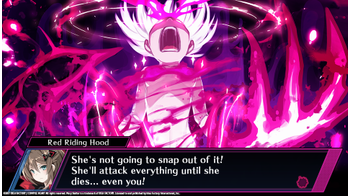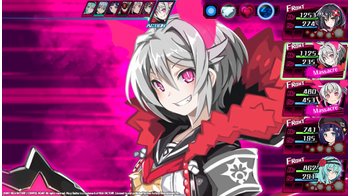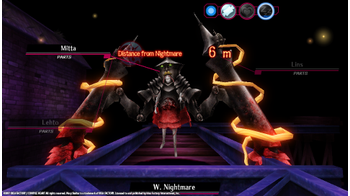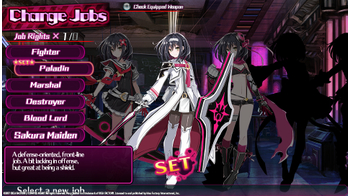Mary Skelter: Nightmares Review
Back when Compile Heart first announced Mary Skelter: Nightmares, it immediately caught my attention. I was drawn to the dark, broody atmosphere and slightly somber character designs. It was something different than the type of fare they typically put out. While it didn’t seem like they were treading new ground, I was interested in the ways it would attempt to hook me in. Unfortunately, they still have work to do.
The story of Mary Skelter is set in this living, breathing Jail that was said to have consumed an entire city that used to be above ground. The Jail can alter its own form through mimicry, consuming both organic and inorganic materials for its own use. Lurking in its rooms and hallways are Marchens, demonic figures that were originally humans and animals, but were altered by the Jail.
This is where we find Jack and Alice, two humans that have been locked away inside this hellscape after being captured by the Marchens. However, they are soon helped by a woman named Red Riding Hood who busts them out of their cells after claiming Alice is a being called a Blood Maiden.
After meeting up with a group of survivors, they learn the existence of The Dawn, a crystal of knowledge for humans. Through their research, they could discover more Blood Maidens. These inexplicable beings possess supernatural powers which allow them to fight the Marchens directly.
Over time, the Blood Maidens gain Corruption from the blood they absorb that gives them powers, but this comes at a price. If they aren’t able to control their powers, they become mentally unstable and can turn into Bloody Skelters, causing them to go on an insane rampage. This becomes the crux of most of the game’s narrative as Jack can bring Alice back from the brink when the need aries.
With the help of Blood Maidens, the last remaining humans hope to fight their way towards a tower that grows in the middle of the Jail. If they can get it to grow to the surface, they’ll be able to flee this purgatory.
If you’ve played one anime dungeon crawler on the PlayStation Vita, you’ve played them all. And no surprise, everything here is straightforward. As you traverse your way through the different levels one step at a time, you’ll come across treasures, item collection points, and various gimmicks such as traps and portals.
You’ll also sometimes come across random encounters. In combat, as you can imagine, your job is to defeat the enemy first before they wipe out your team. Turn order is determined by the agility stat of the character.
The layout of combat reminds me a lot of Moero Chronicle. Jack is always up first and only has access to three commands - Wait, Guard, and Item. You can guard a Blood Maiden, and if successful, they won’t take any damage. But there is also a chance he may be stunned, rendering him useless for a few turns. Stunned one too many times, and he’s knocked out.
The Blood Maidens have more actions available to them. They can Attack, use a Skill, Defend, and Escape from combat (which Jack can also do). You must take into consideration the enemy’s weakness that is based on elements. By using the right skill, inflicting a critical attack, or overkilling an enemy, you will start to fill a Blood Spatter gauge.
Once the gauge is full, the Blood Maiden enters Massacre mode for a set amount of turns. This provides a nice stat bonus across the board while unlocking more powerful skills like the “Massacre Skill.” Outside of those tricks, the combat is simple to understand but as addictive as this genre tends to be.
I’m not sure why the developers think this template works. Maybe they want the only dude to seem useful? Fortunately, unlike Moero Chronicle, I don’t have to listen to the protagonist scream nonstop for hours. Also, Jack’s existence on the team is a lot more intriguing, though still unwarranted. Too bad he feeds into that trope of a sensitive male protagonist without a backbone.
Another mechanic, if you can call it that, gives the Blood Maidens the opportunity to “lick” each other’s blood spatters to trigger a Blood Soul skill. These skills offer a range of restorative benefits like temporary status boosts or a chance to heal one another through. Once the action has been taken, it drains the gauge completely, so you have to choose between the Massacre Mode or the Blood Soul skill. I found it useful when my back was up against the wall in a tough fight.
One feature that throws the wrench into the whole experience is the Nightmares. These invincible creatures can appear out of nowhere and engage you anywhere on the map, even when you’re in combat. They recover after every hit and will keep chasing you out in the field until your entire team is dead. If you happen to encounter it in battle, you are given the chance to knock it down by destroying its parts which buys you some time. Only when you’ve gotten a certain distance away from the Nightmare will you escape from it.
While this seems like a unique in the game at first, you don’t really gain much from it. It’s not like an F.O.E. in Etrian Odyssey where you earn a ton of experience points and money if you defeat it. Rather, you’re only able to run away from these Nightmares. It becomes far more annoying than anything else. Story-wise, it’s the biggest obstacle the humans have to deal with to escape the Jail.
A disappointing carryover from Moero Chronicle (you can tell this was made by the same team despite it not being in the same series) is how you’re only able to save the game at certain spots in the dungeons. Unlike Moero Chronicle, you won’t recover health at these spots. This can be really frustrating when you’re dealing with the later stages, and overall is something I can’t get behind.
I should be able to save wherever I want in a dungeon crawler! And since this is exclusive to the PlayStation Vita, you have the same problem where you have to worry about the system’s battery life between saves. Worse yet if you happen to come across a Nightmare and get a Game Over as I did, losing about 30 minutes of progress. It ruins the vibe when you have such a poor save system in a genre that relies so much on making careful progress.
I made an unfortunate mistake of not noticing one of the characters, Alice, can create Rabbit Holes (get it?) which cost a small amount of SP and allow you to essentially create save points wherever you're at in the dungeon. Through these warps, you're also able to return back to the library (the hub of the game) to restore your HP and SP to full in the meantime. While this does disrupt the flow of the game, somehow I managed to do the amazing thing of completely not noticing this mechanic until someone brought it up to me a day after this review was published.
This won't have an impact on the score as it was a mild inconvenience to begin with, I would like to apologize for my own ignorance of not figuring this out to begin with. I went back and found out there was an even a tutorial explaining this function. So hey, I spent dozens of hours making the experience a bit more difficult than I needed to be, so scratch out this strike against the game as user error.
I should note both games have about the same level of fanservice. There is a rubbing mechanic where you have to rub Jack’s blood on each of the Blood Maidens. It’s very similar to the minigame in Criminal Girls. For those that are bothered by this, you’re only “forced” to do this once before given the choice to skip the scene entirely and earn the enclosed buff. It’s also far less prevalent than in the Moero series.
Don’t go into Mary Skelter expecting anything noteworthy, especially with the story - the last few chapters of the game are terribly executed and lean heavily to anime trope territory. It’s also incredibly easy to maximize each girl’s affection in the game. All you have to do is buy a bunch of cheap presents and dump them on each girl, and voila: maximum affection. These 10 character-specific events are repetitive, with each following the same format.
As I said at the top, Mary Skelter has a far better visual aesthetic than most of the content Compile Heart tends to put out. The overall mood fits into this dark and mysterious direction with an injection of horror elements, and the character art is far more pleasing than most of Compile Heart’s catalog. I particularly liked how the game includes job classes, and the outfits of the characters changed based on their job. It’s a neat touch.
Mary Skelter: Nightmares straddles the line of having fun mechanics and story hooks with a mediocre plot featuring a poor conclusion. If you’re into the whole “dungeon crawler with cute anime girls” approach, like Demon Gaze or Operation Abyss, you’ll appreciate what Mary Skelter has to offer, providing dozens of hours of interesting content. While I wouldn’t recommend picking it up right away, it’s at least worth a try whenever it goes on sale.



